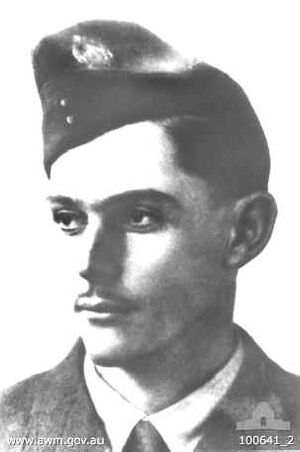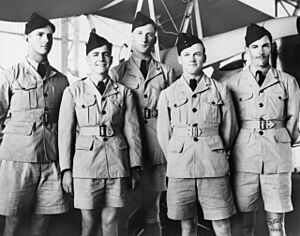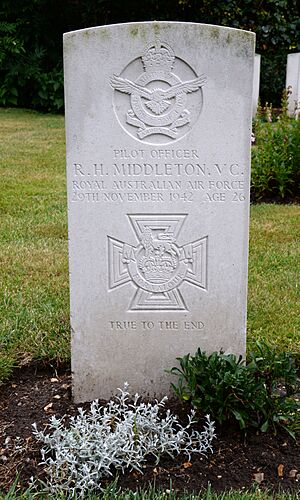Ron Middleton (VC) facts for kids
Quick facts for kids
Rawdon Middleton
|
|
|---|---|

Rawdon Hume (Ron) Middleton
|
|
| Born | 22 July 1916 Sydney, New South Wales |
| Died | 29 November 1942 (aged 26) English Channel |
| Allegiance | Australia |
| Service/ |
Royal Australian Air Force |
| Years of service | 1940–42 |
| Rank | Pilot Officer (posthumously) |
| Unit | No. 149 Squadron RAF |
| Battles/wars | Second World War
|
| Awards | Victoria Cross |
| Relations | Hamilton Hume (great-uncle) |
Rawdon Hume "Ron" Middleton (born 22 July 1916, died 29 November 1942) was a brave pilot in the Royal Australian Air Force. He was awarded the Victoria Cross after his death. The Victoria Cross is the highest award for bravery given to soldiers from Britain and Commonwealth countries.
Contents
Ron's Early Life and Training

Ron Middleton was born on 22 July 1916, in Sydney, Australia. He had a younger brother named Osman. His parents were Faith Lillian and Francis Rawdon Middleton, known as Frank. Ron's great-uncle was the famous explorer, Hamilton Hume.
Ron spent most of his early years in the Central West of New South Wales. His father managed large farms there. The family moved several times as his father took on different farm manager jobs.
School Days and Sports
Ron lived on a farm called 'Alloway' from age nine. He went to a small local school and then to Gilgandra school. He later boarded in Dubbo to finish high school.
Ron was a very active and sporty young man. He played tennis, cricket, and rugby football. He was known for his athletic skills at school.
Joining the Air Force
After school, Ron worked as a jackaroo (a trainee farm manager) on a property near Parkes. On 14 October 1940, he joined the Royal Australian Air Force.
He trained to be a pilot through the Empire Air Training Scheme. He learned to fly in Australia and then in Canada. In February 1942, he joined No. 149 Squadron RAF of the Royal Air Force. He flew as a second pilot on large Short Stirling bomber planes. By July, he became an aircraft captain and led his first bombing mission against Düsseldorf.
His Brave Victoria Cross Mission
On 28 November 1942, Ron Middleton was the captain of a Stirling bomber. His mission was to bomb the Fiat aircraft factory in Turin, Italy. This was his twenty-ninth combat flight. Pilots usually completed a 'tour' after thirty flights, meaning they would then be rotated off combat duty.
Flying Over the Alps
Ron and his crew flew over the Alps mountains. It was a difficult flight because the Stirling bomber, when full of bombs and fuel, could not fly very high. This was due to its short, stubby wings.
Over Turin, Ron had to fly low three times to make sure he hit the right target. On the third pass, his plane was hit by heavy anti-aircraft fire. Both pilots and the wireless operator were badly wounded.
Serious Injuries and Determination
Ron was severely injured. He had many wounds to his arms, legs, and body. He lost sight in his right eye, and his jaw was badly hurt. He briefly passed out.
His second pilot, Flight Sergeant L.A. Hyder, who was also seriously wounded, managed to get control of the plane. He dropped the bombs and then received first aid. Ron woke up and helped to control the damaged bomber.
Even though he was in great pain, could barely see, and was losing a lot of blood, Ron was determined. He wanted to fly his crippled plane back home to save his crew. During the four-hour flight back, he kept saying, "I'll make the English Coast. I'll get you home."
Reaching England and Sacrificing Himself
After hours of struggle, and being hit by more anti-aircraft fire over France, Ron reached the coast of England. He had only five minutes of fuel left. He turned the plane to fly along the coast and told his crew to bail out (jump out with parachutes).
Five of his crew members jumped and landed safely. But his front gunner and flight engineer stayed with him. They tried to convince him to land the plane on the coast. However, Ron knew this could hurt many civilians on the ground.
He steered the plane out over the sea, near Dymchurch. He then ordered the last two crew members to jump. They also bailed out but sadly did not survive the night in the English Channel. Ron stayed with the aircraft, which crashed into the Channel. His body was found on 1 February 1943.
His Legacy of Bravery
The last sentence of his Victoria Cross award description says: "His devotion to duty in the face of overwhelming odds is unsurpassed in the annals of the Royal Air Force." This means his bravery was one of the greatest ever seen in the Royal Air Force.
Ron Middleton was given a higher rank, pilot officer, after his death. He is buried at Beck Row, [Mildenhall], Suffolk. His Victoria Cross medal and uniform are on display at the Australian War Memorial in Canberra.
Other members of his crew also received awards for their bravery during this mission. Pilot Officers George Royde and Norman Skinner received the Distinguished Flying Cross. Flight Sergeant Leslie Hyder, Flight Sergeant Douglas Cameron, and Sergeant H.W. Gough each received the Distinguished Flying Medal.
Remembering Ron Middleton
Ron Middleton is remembered in many ways:
- The mess hall (dining area) at 1 RAAF Recruit Training Unit, RAAF Base Wagga, is named the 'Middleton VC Club'.
- He was featured on one of Australia's 45-cent stamps in 1995.
- The dining hall at RAF Mildenhall in Suffolk, England, is named after him.
- In Parkes, New South Wales, there is a street and a school, Middleton Public School, named in his honor.
- In Gilgandra, New South Wales, the road leading to the local airport is called Middleton Memorial Drive.
- In Dubbo, New South Wales, there is a bronze statue of him with a plaque in Victoria Park.


